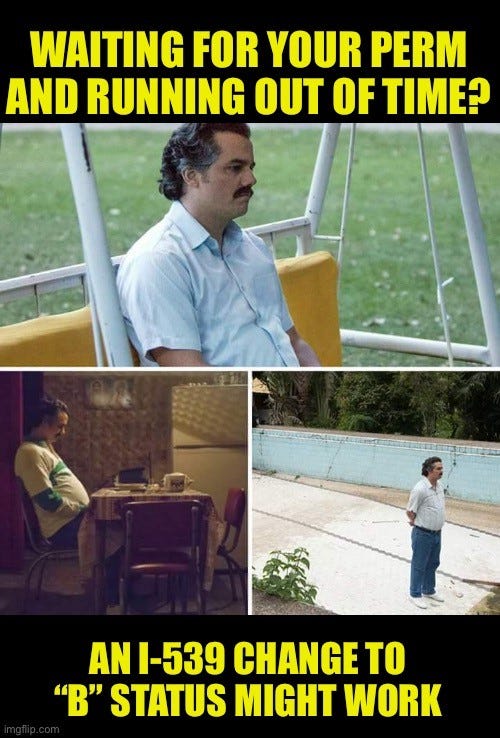PERM Process taking too long?
The PERM labor certification process is the longest it has ever been since PERM was invented in 2005. An I-539 can be useful if you are running out of H-1B time.
This is a quick post to discuss a situation that sometimes occurs for people in H-1B status. But first, some background:
H-1B workers are limited to 6 consecutive years in H-1B status. This is cumulative of employers, so if you spend 4 years at Employer A, then you go to Employer B, you are only eligible for 2 more years at Employer B, for a total of 6 years.
Many H-1B employees need to be sponsored by their employer for a green card. In fact, employer sponsorship is the most common way, by far, for H-1B workers to get a green card. Self-sponsorship, while something great to consider, is simply not applicable to lots of people.
Employer green card sponsorship generally requires 3 stages, with stage 1 being PERM labor certification.
PERM labor certification requires processing with the U.S. Department of Labor (DOL). It requires getting a Form 9141 prevailing wage determination (which can easily take 6 months) and also filing and getting approved a 9089 PERM application form. 9089 processing can take 10+ months. So the PERM process can easily take 16 months just in DOL processing (9141 + 9089), and there are also various other steps involved which can easily take 2-3 additional months. Note that neither 9141 prevailing wage request nor 9089 PERM application processing are eligible for premium processing. It is the slow boat, or no boat!
Because the PERM process is so slow these days (with no end in sight) and because H-1B workers are limited to 6 years of H-1B time, many H-1B workers are running out of time. The problem has become acute in 2022 and 2023 as the PERM processing times have kept getting slower.
Importantly, there are two ways to qualify for H-1B extensions beyond 6 years. Option (i) is to get an approved PERM and approved I-140 and show that the priority date is not current. Then you are eligible for 3 years of additional H-1B time. Option (ii) for an H-1B extension beyond 6 years is that show that the PERM application was filed and has been pending at least 366 days (1 year plus 1 day), then you are eligible for an H-1B extension for 12 months beyond the 6 year limit.
Sadly, these extension options are NOT available for L-1 visa holders. A lot of L-1 visa holders face issues because of slow processing times at DOL and the expansion of cut-off dates to more categories and nationalities, but that’s a separate discussion for a subsequent post!
For various reasons, it may not be possible to qualify for Option (i) or Option (ii) and a person in H-1B status may run out of H-1B time. It is increasingly common to see H-1B workers running out of time EVEN THOUGH their employer is sponsoring them for PERM.
One possible way to stay in the United States if this occurs is for the H-1B worker to file an I-539 application to change status from H-1B to B-2 visitor and wait in the United States until you qualify for an H-1B extension using either Option (i) or (ii) - depending which option becomes available sooner.
Note that you cannot work in the United States if your H-1B time runs out and you file an I-539 application to change to B-2 visa status, so changing to B-2 visa status it not a super great option; but it does allow you to stay in the United States if necessary. And your employer can file for an H-1B extension for you beyond 6 years using either Option (i) or (ii).
One thing to keep in mind is that I-539 processing is ALSO slow so if you pursue this option to change from H-1B to B-2, you might be just waiting in the United States with an I-539 application pending (and not approved) and then while waiting for your I-539, you become eligible for an H-1B extension using either Option (i) or (ii). If that happens, then it is possible to have your employer proceed on the H-1B extension and document your change to B-2 status with the I-539 receipt. We have been successful on this approach in 3 instances where in all 3 instances the I-539 application was still pending when we hoped to extend the H-1B. In all 3 instances it worked and so I mention the I-539 as a possible strategy (a ‘band-aid’) to bridge the gap in the increasingly common situation where an H-1B worker runs out of time while the PERM application is pending.
Perhaps you know someone who can benefit from this approach?



It is good recommendation and thank you for sharing case study. However don't you think applicant has to go out of status hence need to do H1B stamping based on new i797 approval for consular processing and eventually stamping. What the risk in future doing COS using B1/B1, curious to know. cc: @WEBBERIMMIGRATION